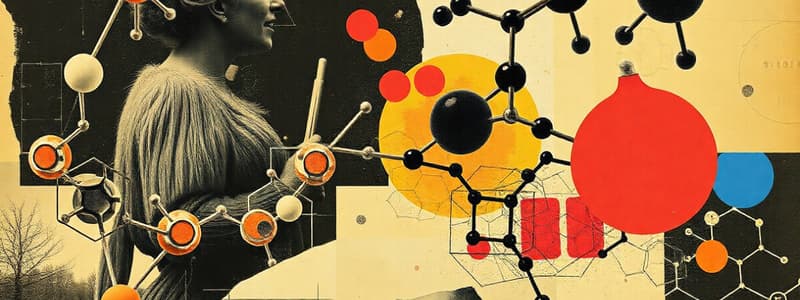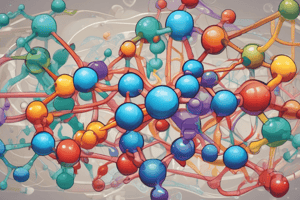Podcast
Questions and Answers
Which elements make up 96% of living organisms?
Which elements make up 96% of living organisms?
- Carbon, Hydrogen, Oxygen, Nitrogen, Sulfur, Phosphorus (correct)
- Oxygen, Hydrogen, Helium, Carbon
- Iron, Zinc, Copper, Manganese
- Calcium, Magnesium, Potassium, Sodium
What are the four main types of molecules that make up living organisms?
What are the four main types of molecules that make up living organisms?
Carbohydrates, Proteins, Fats (Lipids), Nucleic Acids
A _____ is a single organic molecule.
A _____ is a single organic molecule.
monomer
A _____ is many monomers bonded together.
A _____ is many monomers bonded together.
Dehydration synthesis is an exergonic reaction.
Dehydration synthesis is an exergonic reaction.
What is the process called that breaks down polymers into smaller molecules by adding water?
What is the process called that breaks down polymers into smaller molecules by adding water?
Which of the following is an example of an inorganic compound?
Which of the following is an example of an inorganic compound?
Which of the following compounds contain carbon?
Which of the following compounds contain carbon?
Why do we eat?
Why do we eat?
Flashcards are hidden until you start studying
Study Notes
Elements of Life
- 96% of all living things are made from six elements: carbon, hydrogen, oxygen, nitrogen, sulfur, and phosphorus (CHONSP)
- Oxygen accounts for 65% of the mass of a human
- The remaining 4% of elements in living things are considered trace elements, such as calcium, phosphorus, potassium, sulfur, sodium, chlorine, magnesium
Molecules of Life
- Living organisms are formed by combining the six main elements in different ways
- The four main types of molecules in living things are carbohydrates, proteins, fats (lipids), and nucleic acids
- These molecules are built by combining smaller molecules called monomers
- Each molecule is made of a chain of repeating monomers called polymers
Monomers vs. Polymers
- A monomer is a single organic molecule
- A polymer is a large molecule made of many identical monomers linked together
Building Large Organic Molecules
- Monomers bond together to form polymers.
- This process requires energy and is called dehydration synthesis or condensation reaction
Dehydration Synthesis
- A process that uses energy to join monomers, forming larger molecules (polymers)
- This reaction removes water, releasing energy in the form of ATP and heat
- This is an endergonic reaction
- Enzymes help carry out dehydration synthesis
Breaking Down Polymers: Hydrolysis
- Hydrolysis breaks down polymers into smaller molecules (monomers)
- It adds water and releases energy in the form of ATP, making it an exergonic reaction
- Enzymes also help carry out hydrolysis
Example of Digestion
- Starch is broken down into glucose by hydrolysis, releasing energy
Why We Eat
- We eat to take in more chemicals for our bodies.
- We eat to get building materials to grow, repair, and create new cells
- We eat to get energy from food (calories) to produce ATP
Matter in the Human Body
- Living things are mostly made up of organic compounds
- Organic compounds contain carbon
- Inorganic compounds do not contain carbon
- Water is an example of an inorganic compound
- Biomolecules are examples of organic compounds
Arrangement of Elements in Organic Compounds
- Carbon atoms bond to other atoms, forming chains and rings.
- This bonding allows the formation of a diverse variety of organic molecules.
Studying That Suits You
Use AI to generate personalized quizzes and flashcards to suit your learning preferences.




